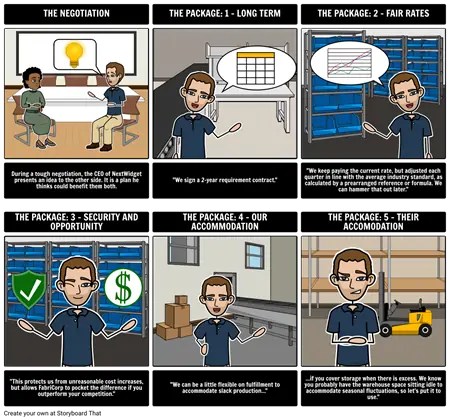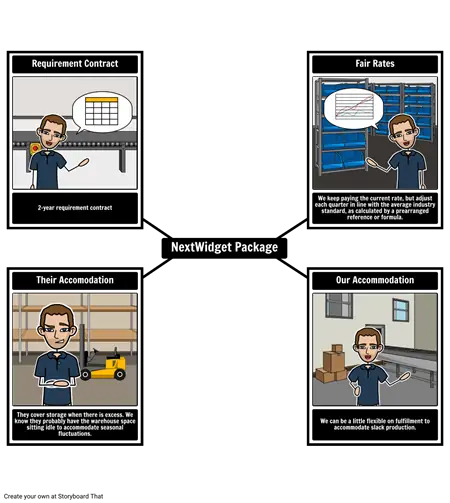Bargaining with Packages

In a traditional negotiation, both sides will come to the table with a list of positions and set about trying to get the best result on each one. Frequently this involves concentrating a single issue until it is completely settled and then going on to slug it out over the next point. This method is called linear, or item-by-item bargaining. It can be an exhausting, frustrating, and lengthy process, but it shows up again and again in divorces, collective bargaining, and international trade talks.
There is an alternative: package bargaining. Unlike item-by-item, packages try to address many issues at the same time. By grouping several items together, concessions can be balanced to maximize the value to each side, even if the monetary value of each isn’t easily assessed. This may seem like common sense, and for smaller negotiations it can be, but when there are dozens of issues under consideration, it can feel easier to hash out each one before moving on.
The linear approach has several benefits; it keeps the agenda orderly and can feel like progress is being made, especially if smaller issues are tackled first. The danger of it is that one item that can’t be resolved threatens to derail the entire process. With packages, each side can feel like they are getting something they want, creating satisfaction and trust that can carry a negotiation through rough patches.
While negotiating packages are frequently used as part of principled negotiations and integrative bargaining, they can be just as effective in distributive bargaining situations. There is no reason why new value needs to be created when negotiating with packages, though integrative bargaining usually isn’t possible without packages.
There are a number of benefits when you bargain with packages, including:
Rationality
Unlike isolated items where a stance can seem arbitrary or self-serving, packages create a sensible and coherent vision. This makes them easier to defend to other negotiators and stakeholders.
Demonstration of Good Faith
Concessions and compromise are an integral part of package bargaining. By showing they are willing to give something up, parties can build trust in each other.
Acknowledgement of Connections
Issues in a negotiation are often linked to each other. By using a package, these connections are acknowledged and accommodated.
Increased Creativity
Expanding the scope of a negotiation from a single issue to a more holistic approach encourages creative solutions. More options means more opportunity, and this can help shift the process from distributive to integrative bargaining.
Palatability
Since the parties have a better chance of getting what they want and a win-win outcome is made more probable, everyone at the table is more likely to agree on a proposal. While not everyone will like everything about a package, it can prevent deadlock and walk-outs.

Practically Speaking
All of this sounds good in theory, but how can you put it into practice? Once you have decided to bargain with packages, here are a few basic steps for negotiation planning to maximize your success:
Draft Early
You can assemble a package even before you know much about the negotiation. Just by reviewing the items under consideration and trying to identify common ground, you’ll have a rough outline of a workable package. This can then be used to direct your investigation, prepare stakeholders, and develop a gameplan for the negotiation.
Revise Frequently
While it’s good to draft some ideas early, it’s important not to stay too attached to them. As you gather more information, both before and during the negotiation, especially about the opposing party, you should revise your initial package. Remember that bargaining packages are solutions to complex problems, and the more you can tailor them to fit the situation, the more satisfied all parties are likely to be. Don’t bargain item by item, but do discuss each item separately so both sides can get a sense of what is at stake and revise their packages.
Present at the Right Time
Deploying your package at the right time is key to making it work. While there is some debate over whether you should try to present first or second, a good rule of thumb is that if you think you have more information, present your offer first. This will anchor the negotiation around your ideas and goals, but does risk being too generous. If you don’t think you’re the best informed at the table, let the other side present first, this will reveal more information to you, and allow you to craft a counter for maximum benefits.
Your package may not always be your first offer. You may hold back on presenting your package until the other side is fatigued and looking for any solution that will settle things, or sufficiently sympathetic that they’ll be receptive to your ideas. You could keep a package as an emergency measure if the negotiation turns against you, but this is very risky.
Defend
Complex solutions don’t always receive warm receptions. Keep in mind that while you have spent time preparing this idea and thinking about the implications, it is new to them. Some negotiators are not used to considering many items at once, or are very wary of the other side. You don’t need to browbeat other negotiators into doing things your way, instead try explaining the benefits of your plan has for both sides. Let them ask questions, give truthful answers, and emphasize that you are presenting the ideas in good faith, as a mutually agreeable solution.
Collaborate
Negotiations are almost always thought of as an adversarial process, but they don’t have to be. If the other party has ideas that could modify your package for the benefit of both sides, consider integrating them. Remember that you won’t always have all, or even most, of the information in a negotiation, and that a successful package will satisfy both sides. Listening to the other party isn’t just a good idea, it’s probably going to be necessary.

Using Storyboard That with Packages
One of the keys to using packages in your negotiation is organization. A spider map is ideal for arranging many issues at a glance, and being able to shift focus between them quickly. Since it is nonlinear, it allows parties to modify or swap components without feeling like the entire plan will fall apart.
A traditional storyboard is another great tool for presenting a package. By implying a narrative structure, the storyboard makes the package feel integrated, logical, and unified. More or less appealing items can be arranged in the storyboard to soften reception and structure reactions.
In the two storyboards below, we can see a package developed and presented by the fictional startup NextWidget in a negotiation with their manufacturer. NextWidget uses bargaining with packages to develop a creative solution they hope can benefit both sides and secure a favorable outcome. For more context, check out our step-by-step guide to negotiation preparation.
How Tos about How to Negotiate by Offering Packages
Make package bargaining interactive with student role-play
Encourage students to act out negotiation scenarios by assigning roles and issues, then forming groups to develop and present package deals. This hands-on approach builds empathy, critical thinking, and collaborative skills while making abstract concepts more tangible.
Prepare clear negotiation scenarios for students
Design simple case studies or fictional disputes with multiple connected issues for students to resolve through package bargaining. Provide background, goals, and constraints to help students focus on creative solutions.
Guide students to brainstorm package options together
Ask each group to list possible items to include in their negotiation package, then discuss trade-offs and priorities. Facilitate open discussion so every voice is heard and creative options are explored.
Support students in presenting and defending their packages
Have groups share their package proposals with the class or another group, explaining benefits for all sides. Encourage respectful questions and feedback to build confidence and negotiation skills.
Reflect and debrief on negotiation outcomes
Lead a class discussion about what strategies worked, how compromises were reached, and what everyone learned about package bargaining. Highlight the importance of creativity and collaboration for successful negotiations.
Frequently Asked Questions about How to Negotiate by Offering Packages
What is package bargaining in negotiations?
Package bargaining is a negotiation approach where multiple issues are grouped together and discussed as a whole, rather than resolving each item one at a time. This method helps balance concessions, fosters creativity, and increases the chance of a win-win outcome for all parties.
How can teachers use package bargaining in classroom activities?
Teachers can introduce package bargaining through role-play scenarios, group projects, or mock negotiations. Students learn to bundle ideas, balance interests, and collaborate on creative solutions, developing real-world problem-solving and communication skills.
What are the main benefits of bargaining with packages?
Bargaining with packages offers benefits like rational decision-making, demonstration of good faith, acknowledgment of issue connections, increased creativity, and greater palatability, making agreements easier and more satisfying for all sides.
What is the difference between item-by-item and package bargaining?
Item-by-item bargaining tackles each issue separately, which can be slow and lead to deadlocks. Package bargaining addresses many issues at once, allowing for balanced trade-offs and more efficient, creative negotiations.
How can Storyboard That help organize package negotiations?
Storyboard That aids package negotiations by offering visual tools like spider maps and storyboards. These help organize issues, present offers clearly, and allow for easy adjustments, making negotiations more effective and engaging.
- flowchart • Sean MacEntee • License Attribution (http://creativecommons.org/licenses/by/2.0/)
© 2025 - Clever Prototypes, LLC - All rights reserved.
StoryboardThat is a trademark of Clever Prototypes, LLC, and Registered in U.S. Patent and Trademark Office

